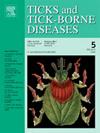Rickettsial exposure in ruminants from Somalia
IF 3.4
2区 医学
Q2 INFECTIOUS DISEASES
引用次数: 0
Abstract
Rickettsia spp. are Gram-negative obligate intracellular bacteria, with Rickettsia africae being transmitted by Amblyomma ticks and posing a zoonotic risk. The status of diseases like rickettsiosis is largely unknown in Somalia. Our study investigates rickettsial exposure in livestock across two different regions in the country. A cross-sectional study collected 372 (190 goats, 133 cattle, 49 sheep) serum samples from the Benadir and Lower Shabelle regions of Somalia. Indirect immunofluorescence assays (IFA) were used to detect anti-R. africae and anti-Rickettsia rhipicephali antibodies, with sera diluted in two-fold increments starting at 1:64. Out of 372 samples, 188/372 (50.5 %) (endpoint titer: 64–2048) were seropositive for rickettsial antigens, with R. africae alone detected in 78/372 (21.0 %) and R. rhipicephali alone in 38/372 (10.2 %). Co-reactivity to both rickettsial antigens occurred in 72/372 (19.4 %) of samples. Cattle showed the highest seroreactivity at 90.2 %, mainly for R. africae, followed by sheep at 28.6 %, and goats at 28.4 %. Cattle and sheep were more likely to be seropositive than goats (OR: 24.5 and 1.1, respectively). This study provides the first serological evidence of Rickettsia spp. in ruminants from Somalia. Our findings suggest heightened susceptibility in cattle, posing health risks to humans, especially if cattle are considered sentinels for human exposure to R. africae.
索马里反刍动物的立克次体暴露
立克次体属革兰氏阴性专性细胞内细菌,非洲立克次体由蜱虫传播,具有人畜共患风险。在索马里,立克次体病等疾病的状况基本上是未知的。我们的研究调查了该国两个不同地区牲畜的立克次体暴露情况。横断面研究从索马里的贝纳迪尔和下谢贝利地区收集了372份血清样本(190只山羊、133头牛、49只绵羊)。间接免疫荧光法(IFA)检测抗r。非洲和抗根瘤体立克次体抗体,从1:64开始以两倍的增量稀释血清。在372份样本中,188/372份(50.5%)(终点滴度:64-2048)立克次体抗原血清阳性,其中78/372份(21.0%)检测到单独的非洲血吸虫,38/372份(10.2%)检测到单独的鼻管绦虫。372份样本中有72份(19.4%)对两种立克次体抗原发生共反应。牛的血清反应率最高,为90.2%,主要是非洲鼠,其次是绵羊(28.6%)和山羊(28.4%)。牛和绵羊比山羊更有可能呈血清阳性(OR分别为24.5和1.1)。本研究首次提供了索马里反刍动物立克次体的血清学证据。我们的研究结果表明,牛的易感性增加,对人类构成健康风险,特别是如果牛被认为是人类接触非洲R.的哨兵。
本文章由计算机程序翻译,如有差异,请以英文原文为准。
求助全文
约1分钟内获得全文
求助全文
来源期刊

Ticks and Tick-borne Diseases
INFECTIOUS DISEASES-MICROBIOLOGY
CiteScore
6.90
自引率
12.50%
发文量
185
审稿时长
6-12 weeks
期刊介绍:
Ticks and Tick-borne Diseases is an international, peer-reviewed scientific journal. It publishes original research papers, short communications, state-of-the-art mini-reviews, letters to the editor, clinical-case studies, announcements of pertinent international meetings, and editorials.
The journal covers a broad spectrum and brings together various disciplines, for example, zoology, microbiology, molecular biology, genetics, mathematical modelling, veterinary and human medicine. Multidisciplinary approaches and the use of conventional and novel methods/methodologies (in the field and in the laboratory) are crucial for deeper understanding of the natural processes and human behaviour/activities that result in human or animal diseases and in economic effects of ticks and tick-borne pathogens. Such understanding is essential for management of tick populations and tick-borne diseases in an effective and environmentally acceptable manner.
 求助内容:
求助内容: 应助结果提醒方式:
应助结果提醒方式:


